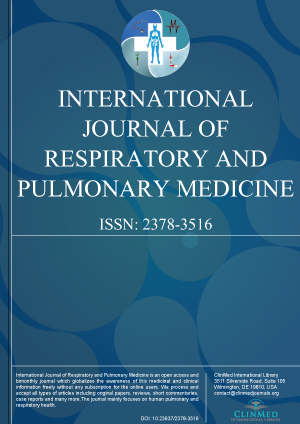Open Access DOI:10.23937/2378-3516/1410064
Inhaler Technology
Gumani D, Newmarch William, Puopolo Angelica and Casserly Brian
Article Type: Review Article | First Published: December 12, 2016
Inhalers are a commonly used device to deliver medication to individuals with airway disease. With correct use, inhalers are very effective at providing quick and effective symptomatic relief within the lung, avoiding high levels of systemic exposure. These pharmacokinetic characteristics widen the therapeutic index, thus allowing for maximal therapeutic benefit with minimal adverse effects. However, this theoretical advantage is somewhat attenuated by incorrect use of the inhaler device....
Open Access DOI:10.23937/2378-3516/1410063
New Guidelines, Less Guidance, and the End of an Era: Healthcare -Associated Pneumonia in 2016
Jeena Jacob and Matthew Crotty
Article Type: Editorial | First Published: November 28, 2016
The 2005 guidelines recommended classification of patients based on their risk of infection by resistant bacterial pathogens. The now abandoned HCAP entity included any patient hospitalized in an acute care hospital for two or more days within 90 days of the infection; residing in a nursing home or long-term care facility; exposed to recent intravenous antibiotic-therapy, chemotherapy, or wound care within the past 30 days of the current infection; or on hemodialysis....
Open Access DOI:10.23937/2378-3516/1410062
Relationship between Documented Confirmation of Endotracheal Tube Position and Mortality in the Emergency Department
Michael P Phelan, Jonathan M Glauser, Fredric M Hustey, Motunrayo Mobolaji-Lawal and Stephen W Meldon
Article Type: Original Research | First Published: November 21, 2016
We analyzed an emergency department (ED) performance improvement (PI) database from an airway registry that was developed to monitor the care of patients undergoing endotracheal intubation in prehospital settings or in the study site ED. PI initiatives included implementation of electronic health record (EHR) documentation templates for ETT placement/confirmation, an online educational module, and performance feedback....
Open Access DOI:10.23937/2378-3516/1410061
Smoking Habit in Adult Population from Maracaibo City, Venezuela
Valmore Bermudez, Edgar Miquilena, Juan Salazar, Robys Gonzalez, Luis Carlos Olivar, Maria Jose Calvo, Roberto Anez, Jose R Rivas-Rios and Joselyn Rojas
Article Type: Research Article | First Published: November 06, 2016
A descriptive, cross-sectional research study, framed in the study Prevalence of Metabolic Syndrome in Maracaibo city conformed by 2,212 adults of both genders; based on the medical information the individuals were classified in smokers, non-smokers and former smokers. Quantitative variables were expressed as medians and qualitative variables as absolute and relative frequencies, using χ2 for significance and Z test for difference of proportions....
Open Access DOI:10.23937/2378-3516/1410060
Possible Complication of Marking Hook Wire Entry into the Systemic Circulation during Video-Assisted Thoracoscopic Surgery
Hiromasa Arai, Michihiko Tajiri, Kohei Ando, Koji Okudela, Tae Iwasawa and Munetaka Masuda
Article Type: Case Report | First Published: October 17, 2016
A 63-year-old Japanese male suffering from interstitial pneumonia underwent computed tomography (CT) guided tumor localization using a hook wire and a suture system for a small pulmonary nodule suspected of being lung carcinoma. He underwent subsequent video-assisted thoracoscopic surgery. The cut suture connecting to the metal head of the hook wire in the lung parenchyma was visible at the beginning of the procedure. During the surgery, the suture was not able to be visualized....
Open Access DOI:10.23937/2378-3516/1410059
Clinical and Radiological Predictor of Polymyositis and Dermatomyositis Associated Interstitial Lung Disease
Tomoo Kishaba, Hiroaki Nagano, Yuichiro Nei, Shin Yamashiro and Harumi Ito
Article Type: Original Article | First Published: October 03, 2016
Background: Polymyositis (PM) and dermatomyositis (DM) often have interstitial lung disease (ILD) and progression of ILD is important cause of death. Objectives: This study is conducted to clarify the important clinical, radiological factors of PM/DM ILD patients. Methods: We reviewed medical records, pulmonary function test (PFT), chest high-resolution computed tomography (HRCT) findings from January 1, 2001 to December 31, 2014 retrospectively at Okinawa Chubu Hospital....
Open Access DOI:10.23937/2378-3516/1410058
Drainage using Chest Tubes Smaller than 20 French is Suitable for Patients with Thoracic Empyema
Ryo Matsunuma, Kazumasa Kase, Nobuhiro Asai, Satoshi Watanabe, Yuko Waseda, Norihiro Kaneko, Masahiro Aoshima, Masaki Fujimura and Kazuo Kasahara
Article Type: Original Article | First Published: October 01, 2016
Background: Patients with thoracic empyema occasionally require chest tubes for drainage. Several studies have reported that smaller chest tubes are effective and cause fewer complications. The aim of this study was to investigate the outcomes of patients with empyema who underwent drainage using a smaller-size chest tube. Methods: We retrospectively reviewed all patients at 2 institutions with thoracic empyema. We performed both univariate and multivariate analysis to examine the relation betwe...

